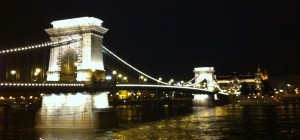
After dinner, my father, daughter and I went out for a short night walk to see Budapest in all its illuminated glory. We felt lucky to have the chance to stand on the pedestrian walkway of the Chain Bridge and gaze at the panorama that stretched out all around us. The city was decked out as if for a fantastic party, its many towers, domes and statues bathed in a silvery glow, the bridges dotted with small white lights.
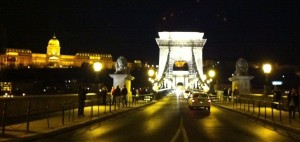
Just beyond the grand arches and reclining lions of the bridge was the magnificent Art Nouveau façade of the Gresham Palace, since 2001 the Four Seasons Hotel. It beckoned, and so we wandered through the soaring public rooms of the ground floor. Amiable doormen and staff greeted us warmly, evidently happy that we were ambling freely through the sparsely peopled space. There was no pressure to buy anything or to defend our right to be there. The hotel’s peaceful, rather dreamlike atmosphere was the perfect prelude to our first night’s sleep on the ship, which would remain docked by the Chain Bridge.
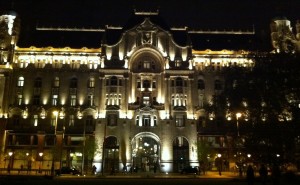
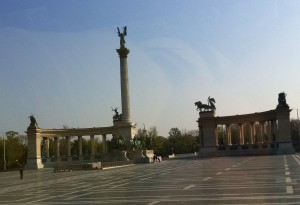
The next day we boarded Viking Cruise buses for a tour of the city. These are the vehicles that my husband so detests, perhaps because he associates them with old age and being trapped in a confined space with other old people. I have no such complaints; I thoroughly enjoyed the buses, with their comfy seats, wall-to-wall windows and high vantage point. We began on the Pest side, proceeding at a leisurely pace along the wide Andrassy Avenue, Budapest’s Champs-Élysées. We passed magnificent homes and the palatial Neo-Renaissance Opera House, famed for its near-perfect acoustics. The street ends at the vast plaza of Heroes’ Square, with its dramatic Millenium Monument commemorating the city’s thousandth anniversary in 1896. Its many statues, in green oxidized bronze, depict tribal leaders and rulers of Hungary throughout the country’s exceptionally long history. With their flowing hair, exuberant drapery, fierce and determined gazes, the Hungarian heroes resemble fairy-tale figures rendered in three dimensions. Bordering the square are rambling Neo-Classical temples which house two of the city’s large art museums.
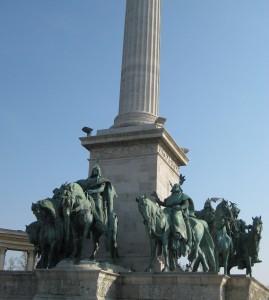
Before we left the bus to explore Heroes’ Square, our guide, a native of Budapest, warned us to ignore the gypsies that target tour groups. Sure enough, a dozen or so women seemed to appear out of nowhere, sidling up to us silently, exhibiting macramé sweaters crocheted from gilded and brightly colored yarn. They nodded solemnly, looking from sweater to tourist, as though to suggest that the purchase of such a flattering garment might be one’s supreme fashion decision. As roaming city vendors go, to us they seemed respectful and non-threatening, a far cry from the loud and aggressive sidewalk merchants of Paris. My mother and I both considered buying a sweater simply because the women were polite and looked so hopeful. Our guide had said the gypsies tend to overcharge and have been known to give change in counterfeit bills. I might as well have made a purchase, since we needed cash only for our admission to the baths. I returned home from the trip with enough, presumably real, Hungarian currency to have bought several of the low-cost sweaters. Those unused forints are stored somewhere in a drawer, awaiting a second chance to rove with Budapest’s Gypsies. I hope they’ll get that opportunity.
